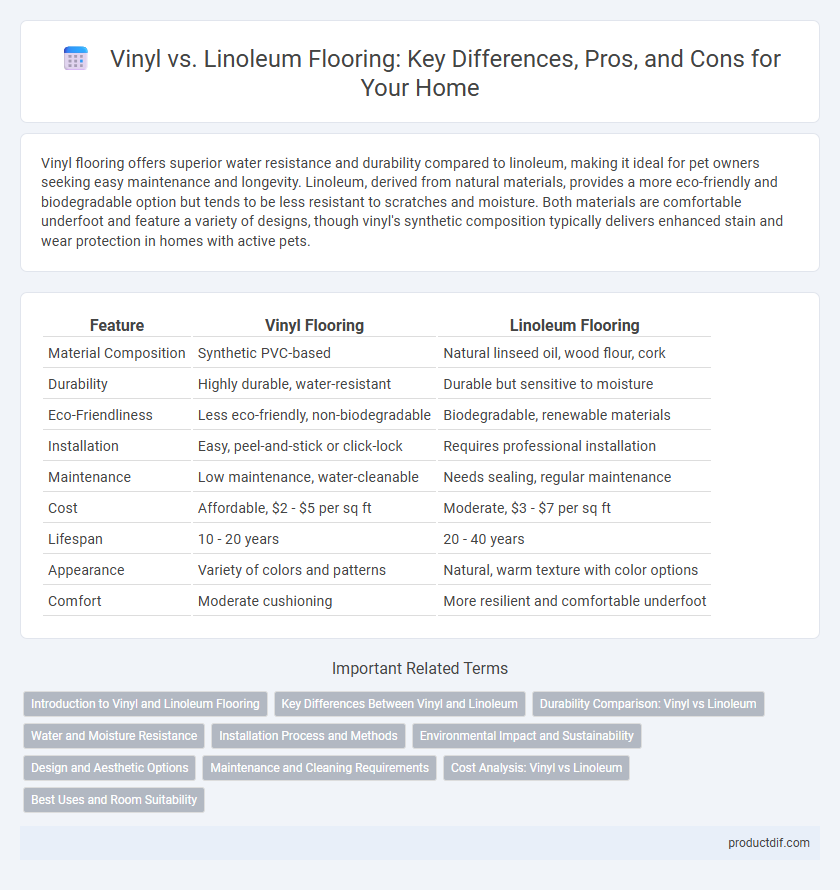Vinyl flooring offers superior water resistance and durability compared to linoleum, making it ideal for pet owners seeking easy maintenance and longevity. Linoleum, derived from natural materials, provides a more eco-friendly and biodegradable option but tends to be less resistant to scratches and moisture. Both materials are comfortable underfoot and feature a variety of designs, though vinyl's synthetic composition typically delivers enhanced stain and wear protection in homes with active pets.
Table of Comparison
| Feature | Vinyl Flooring | Linoleum Flooring |
|---|---|---|
| Material Composition | Synthetic PVC-based | Natural linseed oil, wood flour, cork |
| Durability | Highly durable, water-resistant | Durable but sensitive to moisture |
| Eco-Friendliness | Less eco-friendly, non-biodegradable | Biodegradable, renewable materials |
| Installation | Easy, peel-and-stick or click-lock | Requires professional installation |
| Maintenance | Low maintenance, water-cleanable | Needs sealing, regular maintenance |
| Cost | Affordable, $2 - $5 per sq ft | Moderate, $3 - $7 per sq ft |
| Lifespan | 10 - 20 years | 20 - 40 years |
| Appearance | Variety of colors and patterns | Natural, warm texture with color options |
| Comfort | Moderate cushioning | More resilient and comfortable underfoot |
Introduction to Vinyl and Linoleum Flooring
Vinyl flooring is a synthetic material made from PVC (polyvinyl chloride) known for its durability, water resistance, and wide design variety, making it a popular choice for kitchens and bathrooms. Linoleum, crafted from natural components like linseed oil, cork dust, and wood flour, offers eco-friendly benefits and a biodegradable option with a distinctive matte finish. Both flooring types provide affordable, resilient surfaces but differ significantly in composition, environmental impact, and maintenance requirements.
Key Differences Between Vinyl and Linoleum
Vinyl flooring is a synthetic material made primarily from polyvinyl chloride (PVC), offering high durability and water resistance, while linoleum is a natural product crafted from linseed oil, cork dust, and wood flour, making it biodegradable and eco-friendly. Vinyl typically comes in a wider range of styles, including realistic wood and stone looks, whereas linoleum has a more limited, matte finish palette that may develop a natural patina over time. Maintenance for vinyl requires minimal effort with simple cleaning solutions, whereas linoleum demands regular sealing to maintain its longevity and prevent moisture damage.
Durability Comparison: Vinyl vs Linoleum
Vinyl flooring offers superior water resistance and high durability against scratches and stains, making it ideal for high-traffic areas and moisture-prone environments. Linoleum, composed of natural materials like linseed oil and wood flour, provides a durable surface but is more susceptible to moisture damage and requires regular sealing to maintain longevity. Overall, vinyl's synthetic composition ensures a longer lifespan with less maintenance, while linoleum offers eco-friendly durability with moderate resilience.
Water and Moisture Resistance
Vinyl flooring offers superior water and moisture resistance due to its synthetic composition and waterproof wear layer, making it ideal for bathrooms and kitchens. Linoleum, made from natural materials like linseed oil and cork dust, is more susceptible to water damage and requires proper sealing to prevent moisture absorption. Vinyl's resilience against mold and mildew outperforms linoleum in high-humidity environments, ensuring longer durability and easier maintenance.
Installation Process and Methods
Vinyl flooring installation involves a variety of methods including glue-down, peel-and-stick, and click-lock floating floors, offering flexibility for DIY or professional applications. Linoleum requires precise subfloor preparation and is typically installed using adhesive, which demands skilled application to prevent bubbles and ensure durability. Both materials benefit from moisture barriers, but vinyl's versatile installation options make it more adaptable to uneven surfaces compared to linoleum.
Environmental Impact and Sustainability
Vinyl flooring is made from polyvinyl chloride (PVC), a synthetic plastic that releases harmful chemicals during production and disposal, contributing to environmental pollution and landfill waste. Linoleum, composed of natural materials such as linseed oil, cork dust, and wood flour, is biodegradable and has a significantly lower carbon footprint. Choosing linoleum over vinyl supports sustainability goals by reducing toxic emissions and promoting renewable resources in flooring materials.
Design and Aesthetic Options
Vinyl flooring offers a vast array of design options, including realistic wood, stone, and tile patterns, often enhanced by high-definition printing technology for a more authentic look. Linoleum, crafted from natural materials, features unique marbled and speckled designs with vibrant color choices that age gracefully over time, developing a rich patina. Both materials provide versatile aesthetic solutions, but vinyl excels in mimicking diverse textures while linoleum emphasizes eco-friendly, timeless visual appeal.
Maintenance and Cleaning Requirements
Vinyl flooring offers low-maintenance cleaning with simple sweeping and mopping, resisting stains and moisture effectively. Linoleum requires periodic sealing to protect against water damage and can be cleaned with mild soap and water, but it's more prone to wear if not maintained properly. Both materials benefit from routine care, but vinyl's water resistance makes it more suitable for high-traffic or moisture-prone areas.
Cost Analysis: Vinyl vs Linoleum
Vinyl flooring generally costs between $2 to $5 per square foot, making it a budget-friendly option compared to linoleum, which typically ranges from $3 to $7 per square foot. Installation expenses for vinyl tend to be lower due to its easier handling and adhesive options, while linoleum may require professional installation because of its more rigid composition. Long-term maintenance costs also favor vinyl, as it is more resistant to moisture and stains, reducing repair and upkeep expenses compared to linoleum.
Best Uses and Room Suitability
Vinyl flooring excels in high-traffic areas like kitchens and bathrooms due to its water resistance and durability, making it ideal for moisture-prone rooms. Linoleum offers eco-friendly benefits with natural materials, serving well in low-traffic spaces such as living rooms or bedrooms where its breathability helps maintain indoor air quality. Both materials provide versatile designs, but vinyl stands out for commercial environments while linoleum suits residential settings emphasizing sustainability.
Vinyl vs Linoleum Infographic

 productdif.com
productdif.com